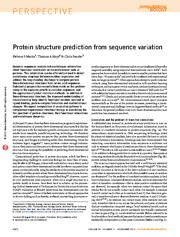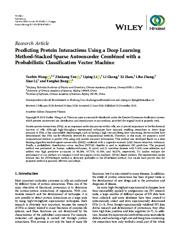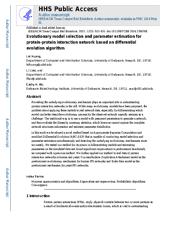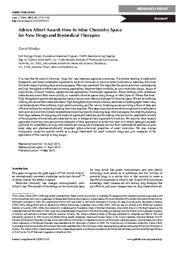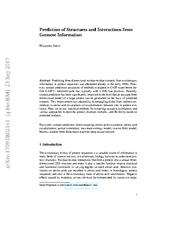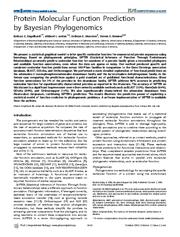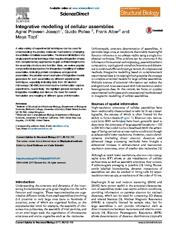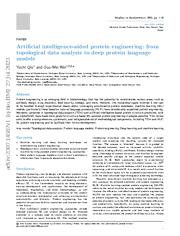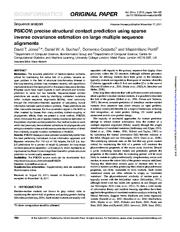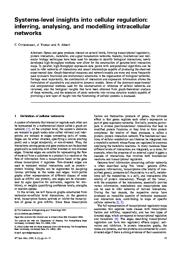A copy of this work was available on the public web and has been preserved in the Wayback Machine. The capture dates from 2020; you can also visit the original URL.
The file type is application/pdf.
Filters
Computational Approaches for Automated Classification of Enzyme Sequences
2011
Journal of Proteomics & Bioinformatics
Since this method is dependent on the protein-ligand interactions data, near complete and more accurate information on such interactions are necessary to achieve higher accuracy in function prediction. ...
In addition to evolutionary information, functional domain information of protein sequence was used to develop a method known as EzyPred [34] with an overall accuracy of 91%. ...
Funding This work was supported by National Institutes of Health [1R01GM086533-01A1 to CG]; and startup funds to CG from University of Nebraska Medical Center. ...
doi:10.4172/jpb.1000183
pmid:22114367
pmcid:PMC3221388
fatcat:jlmaj467obelvnrdcicn3kjkey
Protein structure prediction from sequence variation
2012
Nature Biotechnology
This information can be efficiently mined to detect evolutionary couplings between residues in proteins and address the long-standing challenge to compute protein three-dimensional structures from amino ...
We expect computation of covariation patterns to complement experimental structural biology in elucidating the full spectrum of protein structures, their functional interactions and evolutionary dynamics ...
(a) Besides the prediction of monomer three-dimensional structure ('within self'), in principle, evolutionary couplings can be used to deduce additional functional interactions (between a target protein ...
doi:10.1038/nbt.2419
pmid:23138306
pmcid:PMC4319528
fatcat:rkbhf4on7bcuvcabgdyghtrchi
Predicting Protein Interactions Using a Deep Learning Method-Stacked Sparse Autoencoder Combined with a Probabilistic Classification Vector Machine
2018
Complexity
Therefore, in this study, we propose a novel computational method to predict PPIs using only protein sequence information. ...
Protein-protein interactions (PPIs), as an important molecular process within cells, are of pivotal importance in the biochemical function of cells. ...
The authors would like to thank the editors and anonymous reviewers for their constructive advice. ...
doi:10.1155/2018/4216813
fatcat:lq4zmf2vmne3xckrq2nvblq4pm
Evolutionary Model Selection and Parameter Estimation for Protein-Protein Interaction Network Based on Differential Evolution Algorithm
2015
IEEE/ACM Transactions on Computational Biology & Bioinformatics
Revealing the underlying evolutionary mechanism plays an important role in understanding protein interaction networks in the cell. ...
The traditional way is to use a model with presumed parameters to generate a network, and then evaluate the fitness by summary statistics, which however cannot capture the complete network structures information ...
Acknowledgments Funding: Delaware INBRE program, with grants from the National Center for Research ResourcesNCRR (5P20RR016472-12) and the National Institute of General Medical SciencesNIGMS (8 P20 GM103446 ...
doi:10.1109/tcbb.2014.2366748
pmid:26357273
pmcid:PMC4719153
fatcat:v3xj2mj6zrbr7o4ek6vxj5f5ca
Disentangling Interactions in the Microbiome: A Network Perspective
2017
Trends in Microbiology
Network-based analytical approaches have the potential to help disentangle complex polymicrobial and microbe-host interactions, and thereby further the applicability of microbiome research to personalized ...
In this review, we highlight recent advances in network theory and their applicability to microbiome research. ...
MCL has found great popularity in network biology and has been used to characterize protein families within protein networks [75] , detect orthologous and homologous groups [76] , predict protein complexes ...
doi:10.1016/j.tim.2016.11.008
pmid:27916383
pmcid:PMC7172547
fatcat:3zcr5exogfce5hizfqcr6grflm
Adrien Albert Award: How to Mine Chemistry Space for New Drugs and Biomedical Therapies
2015
Australian journal of chemistry (Print)
designing new bioactive agents and materials, and for making truly predictive, quantitative models of the properties of molecules and materials for use in therapeutic and regenerative medicine. ...
We describe these broadly applicable modelling tools and provide examples of their application to serum free stem cell culture, pathogen resistant polymers for implantable devices, new markers and biological ...
Financial support from the CSIRO Advanced Materials Platform, a Newton Turner award for Exceptional Senior Scientists, and a Monash University-Nottingham travelling fellowship are also ...
doi:10.1071/ch15172
fatcat:xfkyglmjj5hz5gdqvf5nu7qeea
Prediction of Structures and Interactions from Genome Information
[article]
2017
arXiv
pre-print
level that an accurate three dimensional model of a large protein can be generated on the basis of predicted contacts. ...
Predicting three dimensional residue-residue contacts from evolutionary information in protein sequences was attempted already in the early 1990s. ...
of known 3D structure, predicted protein-protein contacts in 32 complexes of unknown structure, and then demonstrated how evolutionary direct couplings can be used to distinguish between interacting and ...
arXiv:1709.08021v1
fatcat:3sxrv2ifjzeu7a5e65ybf6siia
Protein Molecular Function Prediction by Bayesian Phylogenomics
2005
PLoS Computational Biology
Based on phylogenomic principles, SIFTER (Statistical Inference of Function Through Evolutionary Relationships) accurately predicts molecular function for members of a protein family given a reconciled ...
We present a statistical graphical model to infer specific molecular function for unannotated protein sequences using homology. ...
Other approaches, referred to as context methods, predict protein function using evolutionary information and protein expression and interaction data [21] [22] [23] [24] [25] [26] . ...
doi:10.1371/journal.pcbi.0010045
pmid:16217548
pmcid:PMC1246806
fatcat:kjzqzpy3zng4xpoi6vkeuxqt4y
Persistent spectral theory-guided protein engineering
[article]
2022
bioRxiv
pre-print
This work introduces a Topology-offered protein Fitness (TopFit) framework to complement protein sequence and structure embeddings. ...
While protein engineering, which iteratively optimizes protein fitness by screening the gigantic mutational space, is constrained by experimental capacity, various machine learning models have substantially ...
We thank Chloe Hsu and Jennifer Listgarten for helpful discussions. ...
doi:10.1101/2022.12.18.520933
fatcat:yimhafumbzextaili5tbeeihae
Integrative modelling of cellular assemblies
2017
Current Opinion in Structural Biology
We highlight general concepts in integrative modelling and discuss the need for careful formulation and merging of different types of information. ...
Here, we review popular computational approaches for integrative modelling of cellular assemblies, including protein complexes and genomic assemblies. ...
Acknowledgments We thank the support from the MRC project grant MR/M019292/1 (MT) and the Arnold and Mabel Beckman foundation (BYI program), NIH U54DK107981, R01GM096089, NSF CAREER (1150287) (FA). ...
doi:10.1016/j.sbi.2017.07.001
pmid:28735107
pmcid:PMC5683902
fatcat:yh3uircisned5ipz5lfjz523q4
Artificial intelligence-aided protein engineering: from topological data analysis to deep protein language models
[article]
2023
arXiv
pre-print
This review aims to offer a comprehensive, systematic, and indispensable set of methodological components, including TDA and NLP, for protein engineering and to facilitate their future development. ...
Moreover, advances in topological data analysis (TDA) and artificial intelligence-based protein structure prediction, such as AlphaFold2, have made more powerful structure-based ML-assisted protein engineering ...
Corporation, MSU Foundation, Bristol-Myers Squibb 65109, and Pfizer. ...
arXiv:2307.14587v1
fatcat:hwpfrkslcjdrfbyaelxdvufgnm
PSICOV: precise structural contact prediction using sparse inverse covariance estimation on large multiple sequence alignments
2011
Computer applications in the biosciences : CABIOS
to be of significant benefit in protein structure prediction or model quality assessment. ...
Here we present a novel method, PSICOV, which introduces the use of sparse inverse covariance estimation to the problem of protein contact prediction. ...
We also thank Erik van Nimwegen and Lukas Burger for providing code to implement their Bayesian network approach. Conflict of Interest: none declared. ...
doi:10.1093/bioinformatics/btr638
pmid:22101153
fatcat:zygnm6nqzvbgzh7tmnc37nguli
Probing the properties of molecules and complex materials using machine learning
2022
Australian journal of chemistry (Print)
The application of machine learning to predicting the properties of small and large discrete (single) molecules and complex materials (polymeric, extended or mixtures of molecules) has been increasing ...
This Account summarises three decades of research into improved cheminformatics and machine learning methods and their application to drug design, regenerative medicine, biomaterials, porous and 2D materials ...
I'm also very grateful to the computational and experimental scientists with whom I have collaborated, ...
doi:10.1071/ch22138
fatcat:akfhsqauxbes5e6bx4ofg6yobi
Systems-level insights into cellular regulation: inferring, analysing, and modelling intracellular networks
2007
IET Systems Biology
Perhaps most importantly, the combination of interaction and expression information allows the formulation of quantitative and predictive dynamic models. ...
Graph-theoretical measures and network models are more and more frequently used to discern functional and evolutionary constraints in the organisation of biological networks. ...
Note that these network models aim to identify the main evolutionary mechanisms shaping the topology of cellular interaction networks across organisms and not to predict individual gene duplication events ...
doi:10.1049/iet-syb:20060071
pmid:17441550
fatcat:ttoq55gpxzaszbmjvctrtcitqe
How networks change with time
2012
Bioinformatics
of protein co-expression and protein-protein interaction maps. ...
These models can be hierarchical, with larger complexes containing sub-complexes with more fine-grained interaction probabilities. Networks are observed at specific time points, termed 'snapshots', ...
We acknowledge funding from the NIH and the Kleberg Foundation. Funding: National Institutes of Health and Kleberg Foundation. ...
doi:10.1093/bioinformatics/bts211
pmid:22689777
pmcid:PMC3371843
fatcat:tivxvyzaqvbwlcfv7mrdwl32se
« Previous
Showing results 1 — 15 out of 1,106 results

